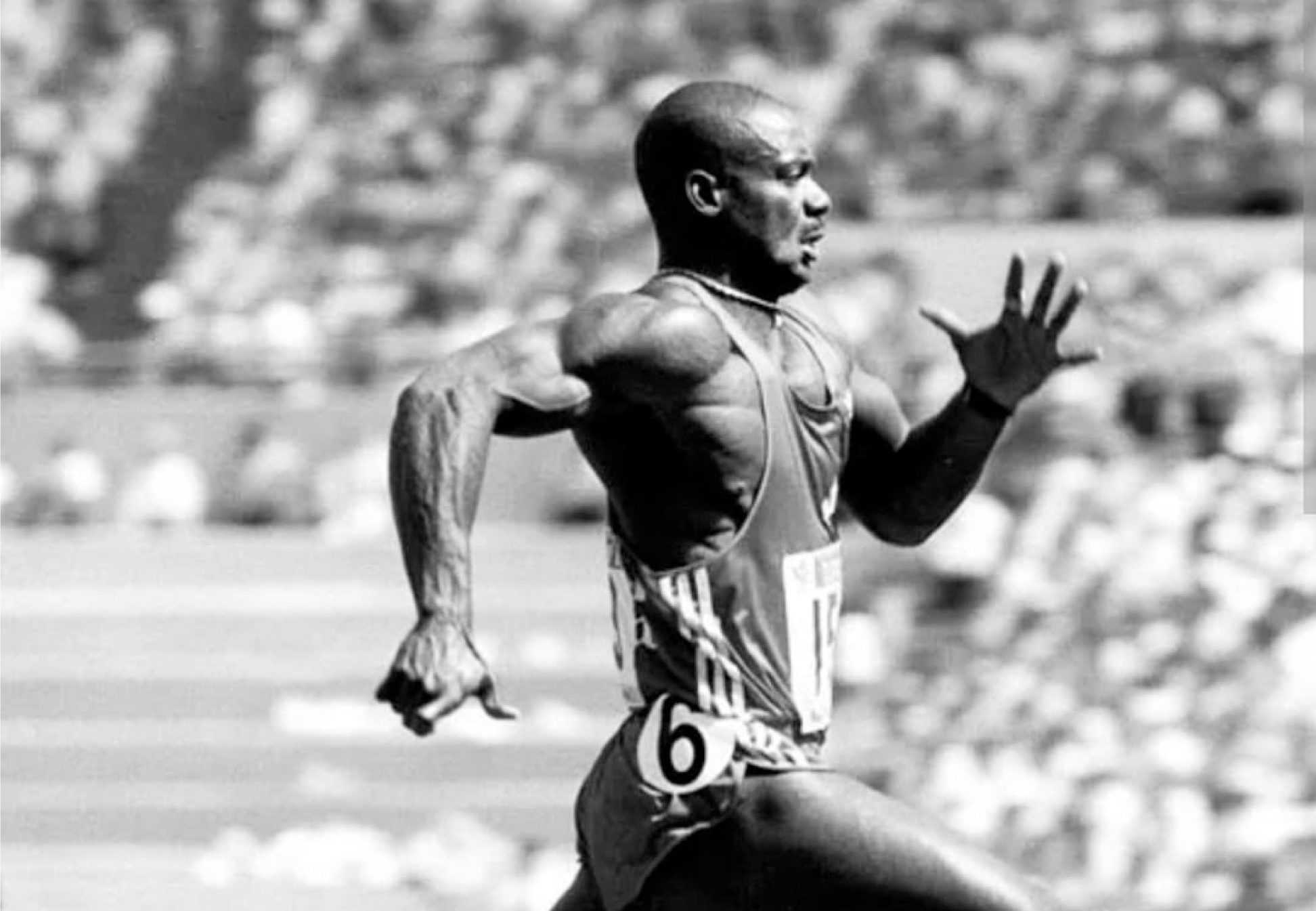on
BY SIMONE J. SMITH
“I wanted to tell my story for a long time; I wanted to tell everyone all at once. Now I can speak the truth and tell everyone exactly what was going on. I am here to tell the truth.”
For twenty-four hours in the summer of 1988, Canada’s Ben Johnson was the most celebrated athlete on the planet. Then just like that, his life changed forever. He was stripped of the 100-meter gold medal he’d possessed for just three days.
Disqualified! For what? Just like that, he plummeted from champion, new multi-millionaire and global star to what Canada propagated as a disgrace. I will never forget hearing my dad read the headlines when he won. “Canada’s Ben Johnson Wins Gold,” to “Jamaican Born Ben Johnson Disqualified for Steroid Use!” Even at a young age, I found that strange.
36 years have passed by since he ran 9.79 seconds in the 100-meter final at the 1988 Seoul Olympics. The young fellow who was at the epicenter of Canada’s worst sports disaster, had to go through years of people doubting him, ignoring his pleas for someone to look into what had been going on.
“They took away my name, my rights to earn a living, it was very tough; people wouldn’t be able to last two weeks, I did it for 36 years.”
The sprint he won in Seoul has since been called “the dirtiest race in history,” with six of the eight competitors linked to doping infractions. The steroid for which Johnson tested positive was not the steroid he believed he was using. His drug screening was riddled with irregularities and crucial testing evidence was withheld by Olympic officials in Seoul, circumstances that credible experts now say denied Johnson his right to due process and should have prevented his disqualification.
Among the troubling issues at his hearing before International Olympic Committee medical commission members: Ben Johnson’s drug test analysis was riddled with unsigned handwritten alterations, including a changed athlete-identification code; a second unofficial urine test (which reportedly tracked long-time steroid use) was dropped on shocked Canadian officials who, in turn, did not challenge this lack of disclosure, or the reason for the test. Of course, now it is coming out that the IOC medical commission gave the benefit of the doubt to some athletes facing doping sanctions in Seoul, but not others.
American forensic toxicologist Dr. David Black, an expert witness in doping matters who was once hired by Ben Johnson, reviewed the former sprinter’s post-race urine screening documentation from Seoul. Dr. Black called the data “Unacceptable under current laboratory requirements and should have been unacceptable in 1988.”
For years, I have been curious about the Ben Johnson story, and when I had a chance to meet him a few years ago, I had so many questions. He was very reserved, and told me that when the time was right, he would tell me everything. Well the time has come, and with the April 16th, 2024 release of his book, “World’s Fastest Man: The Incredible Life of Ben Johnson” by Mary Ormsby Ben finally has the chance to tell his story, the way that it was supposed to be told.
I sat down with Ben, and to be honest, I just let him share.
“My older brother was an athlete, and I came home with a few ribbons from my track and field matches. He asked what I ran at these events. He was impressed with my results, and he invited me to the track and field, and that is when I met Charlie Francis.”
“The early years of my career were tough; the child that I wanted to be I couldn’t be. My childhood was taken away from me completely because I went from Jamaica to Canada and right into track and field, so I didn’t have time to play with other kids or have fun. I found my destiny at 14 years old. People saw my talents. I was only 98 pounds when I came to Canada and started running track. A lot of the other athletes were a lot bigger than me, so they were faster than me. I started to put on weight and mass, and in 1981 a shift happened. I became one of the fastest young men in Canada. I made the national team in 1981. I will never forget my race with Daniel Creary who was my hero. To race against him was incredible.”
“It was the 1984 Olympics that I won bronze, and the Americans didn’t like me at all. I had beat out their third-place guy. I got more recognition and now more needed to be done. I had to get faster and stronger, and when everyone was on vacation, I was training for the next year. I wanted to keep building on that. That was my secret, I was always building and improving. All the hard work and sacrifice led me to winning the gold medal, and this was all for my mom.”
“Leading up to that race, I was worried. I was not afraid of my opponents; I was afraid of failing. It was my time to show the world. I wanted to get the race over with so much; the pressure was on me to get it over with and cross the line. When I crossed the finish line, it was a great feeling, a great moment. Nothing could beat that feeling.”
“The lab results from 1988 were the wrong lab results. They were not even my lab results. There were scribbles, crossed out information; the federation got their hands on these lab reports, and they knew the truth and locked it away. They knew that what they were doing was wrong, and I would not be able to go after them.”
“The double inquiry was a scam; they wanted to separate themselves from Ben Johnson and to present me as the poster boy for steroids. I saw the results 36 years later; I didn’t get due process. I read it and I was like ‘Wow!’ They went all the way to do this to me, to create a lynch against me.”
“I remember something clearly, something that has never left my mind. In 1985 my mom said to me, ‘Son, the only way they can beat you in the testing room. They can’t beat you any other way.” I had to prepare for the worst after that. I knew that it was coming, I had to prepare myself for it, and nothing can truly prepare you for what I went through. I will say this; they never took anything away from me, they just slowed me down.”
“Thankfully, my name still carried a lot of weight around the world. I was still able to conduct my business and make my money. I went through life and did my thing. 18 years ago, I thought about what my mom said. They made that 9.79 Documentary on my life, and the narrative started to shift.”
I have learned that there was a lot going on in sports at the time, some things that we did not know about. During that time, there was a growing list of world-class sprinters with doping histories and Olympic medals. Of the Seoul 100-meter finalists, Carl Lewis, winner of four golds in 1984, was absolved of stimulant infractions weeks before he was awarded the 1988 gold; Linford Christie tested positive for the steroid nandrolone in 1999, seven years after racing to Olympic 100-meter gold in Barcelona and 11 years after narrowly avoiding a stimulant violation in Seoul, where he earned a silver.
Then there was Dennis Mitchell who retained his Barcelona bronze after high testosterone levels were detected in his 1998 urine sample. It’s not only late-20th-century sprinters on this list. American Justin Gatlin, for instance, failed two drug tests (in 2001 and 2006), and won Olympic medals (gold in 2004, bronze in 2012, silver in 2016) before and after serving his four-year doping ban (from 2006 to 2010).
Ben Johnson’s book shows all that was done to him; what was seen, and what was unseen. There is so much that people will learn about what happened during that time, and the insidious actions that were taken to break him.
Stay in the loop with exclusive news, stories, and insights—delivered straight to your inbox. No fluff, just real content that matters. Sign up today!
We, as humans are guaranteed certain things in life: stressors, taxes, bills and death are the first thoughts that pop to mind. It is not uncommon that many people find a hard time dealing with these daily life stressors, and at times will find themselves losing control over their lives. Simone Jennifer Smith’s great passion is using the gifts that have been given to her, to help educate her clients on how to live meaningful lives. The Hear to Help Team consists of powerfully motivated individuals, who like Simone, see that there is a need in this world; a need for real connection. As the founder and Director of Hear 2 Help, Simone leads a team that goes out into the community day to day, servicing families with their educational, legal and mental health needs.Her dedication shows in her Toronto Caribbean newspaper articles, and in her role as a host on the TCN TV Network.












